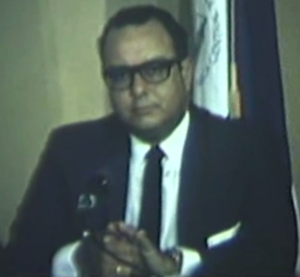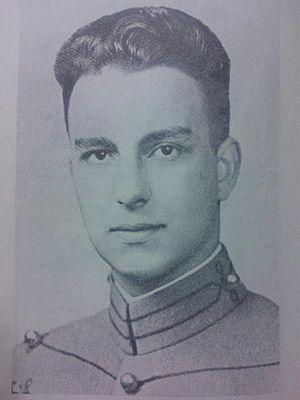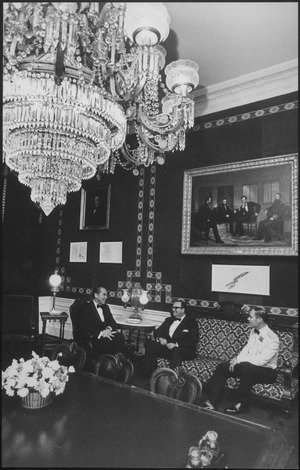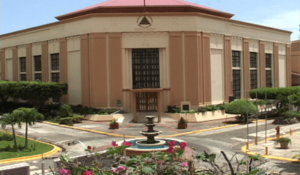Anastasio Somoza Debayle facts for kids
Quick facts for kids
Anastasio Somoza Debayle
|
|
|---|---|
 |
|
| President of Nicaragua | |
| In office 1 December 1974 – 17 July 1979 |
|
| Vice President | Vacant |
| Preceded by | Liberal-Conservative Junta |
| Succeeded by | Francisco Urcuyo (Acting) |
| In office 1 May 1967 – 1 May 1972 |
|
| Vice President | Francisco Urcuyo Alfonso Callejas Deshón |
| Preceded by | Lorenzo Guerrero |
| Succeeded by | Liberal-Conservative Junta |
| Personal details | |
| Born | 5 December 1925 León, Nicaragua |
| Died | 17 September 1980 (aged 54) Asunción, Paraguay |
| Cause of death | Assassination |
| Resting place | Caballero Rivero Woodlawn Park North Cemetery and Mausoleum |
| Political party | Nationalist Liberal Party (PLN) |
| Spouse | Hope Portocarrero (m. 1950 – divorced 1970s) |
| Children | Anastasio Somoza Portocarrero, Julio Somoza Portocarrero, Carolina Somoza Portocarrero, Carla Somoza Portocarrero, Roberto Somoza Portocarrero |
| Parents |
|
| Military service | |
| Allegiance | |
| Branch/service | National Guard |
| Years of service | 1946-1979 |
| Battles/wars | Nicaraguan Revolution |
Anastasio "Tachito" Somoza Debayle (born December 5, 1925 – died September 17, 1980) was a president of Nicaragua. He served two terms: from 1967 to 1972, and again from 1974 to 1979. He was also the head of Nicaragua's army, called the National Guard. This made him the real leader of the country even when he wasn't officially president.
Anastasio Somoza Debayle was the last leader from the powerful Somoza family. His family had ruled Nicaragua since 1937. In July 1979, a group called the Sandinista National Liberation Front (FSLN) fought against his government. Somoza then left Nicaragua. He was killed in 1980 while living in Paraguay.
Contents
Understanding His Name
In many Spanish-speaking countries, people use both their father's and mother's last names. So, "Somoza" was his father's last name, and "Debayle" was his mother's. His mother's family had French roots.
His Early Life and Education
Anastasio Somoza Debayle was born in 1925. His father nicknamed him "Tachito," which means "Little Tacho." When he was seven, he went to a school run by the Christian Brothers. One of his classmates later became a famous journalist and a strong opponent of his family's rule.
From age ten, Tachito studied in the United States. He and his older brother, Luis Somoza Debayle, attended schools in Florida and New York. During this time, their father became president of Nicaragua.

Somoza Debayle later joined the United States Military Academy at West Point in 1943 and graduated in 1946.
After returning to Nicaragua, his father made him the chief of staff of the National Guard. This was Nicaragua's national army. As the Guard's commander, young Somoza became the second most powerful person in the country.
In 1950, Somoza married his cousin, Hope Portocarrero. Their wedding was a big event in Managua, with over 4,000 guests. They had five children together:
- Anastasio Somoza Portocarrero
- Julio Somoza Portocarrero
- Carolina Somoza Portocarrero
- Carla Somoza Portocarrero
- Roberto Somoza Portocarrero
After his father was killed in 1956, Anastasio's older brother, Luis, became president. Anastasio still played a big role in the government during this time.
His Time as President
Anastasio Somoza was elected president in 1967 and took office in May, shortly after his brother passed away. While his brother Luis had been a bit gentler, Anastasio was very strict. His rule quickly became similar to his father's, with strong actions against anyone who disagreed with him.
Somoza was supposed to leave office in 1972 because presidents couldn't be re-elected right away. However, he made a deal to run for president again in 1974. During the time he wasn't officially president (1972-1974), a three-person group took his place. But Somoza still controlled the National Guard, so he remained the true leader.
On December 23, 1972, a strong earthquake hit Managua, Nicaragua's capital. About 5,000 people died, and the city was almost completely destroyed. The government declared a state of emergency, and Somoza took full control. He was accused of taking a lot of the money that was sent from other countries to help rebuild Managua. Even today, some parts of Managua have not been fully rebuilt.
Somoza was re-elected president in 1974. By this time, the Catholic Church and human rights groups started speaking out against his government. Support for the Sandinistas grew both inside and outside Nicaragua.
Economic Situation Under Somoza
During Somoza's time, Nicaragua's economy grew, but the money was not shared fairly. The Somoza family controlled most of the country's businesses. Spending on social programs, like education, was low. In the late 1970s, many children did not finish primary school, and most people in rural areas could not read or write. The number of young children suffering from poor nutrition also increased.
His Fall from Power
In 1975, Somoza started a strong campaign to stop the Sandinistas. The Sandinistas, named after a Nicaraguan rebel leader from the 1920s, had been fighting against the Somoza family since 1963. They received money from the Soviet Union and Cuba.
Support for the Sandinistas grew even more after the earthquake. Also, U.S. President Jimmy Carter stopped supporting Somoza's government because of concerns about human rights.

On July 17, 1979, Somoza resigned as president and flew to Miami. He took with him the coffins of his father and brother. It is also said that he took a large amount of Nicaragua's national money. Nicaragua was left with a huge debt. After Somoza left, the Sandinistas found very little money left in the national treasury.
President Carter did not allow Somoza to stay in the U.S. So, Somoza went to live in Paraguay. The president of Nicaragua's parliament took over as acting president for just one day before peacefully handing power to the Sandinistas.
His Assassination
Just over a year later, on September 17, 1980, Somoza was killed in Paraguay. He was 54 years old. A team of seven Sandinista fighters ambushed him. This action was called "Operation Reptile."
Somoza was buried in Miami. His father, Somoza Garcia, was buried in Nicaragua. A few months before he died, Somoza's book, Nicaragua Betrayed, was published. In it, he blamed the U.S. government for his downfall. His son, Anastasio Somoza Portocarrero, later went to live in Guatemala.
Some experts believe that the plan to kill Somoza was made in Cuba, with direct help from Fidel Castro.
In 1979, a Brazilian newspaper estimated that the Somoza family's wealth was between $2 billion and $4 billion. Anastasio Somoza Debayle himself was thought to own $1 billion. When he left Nicaragua, he reportedly controlled 22 percent of the country's farmland.
See Also
 In Spanish: Anastasio Somoza Debayle para niños
In Spanish: Anastasio Somoza Debayle para niños
- National Guard (Nicaragua)
- Nicaraguan Revolution
- Somoza Family


